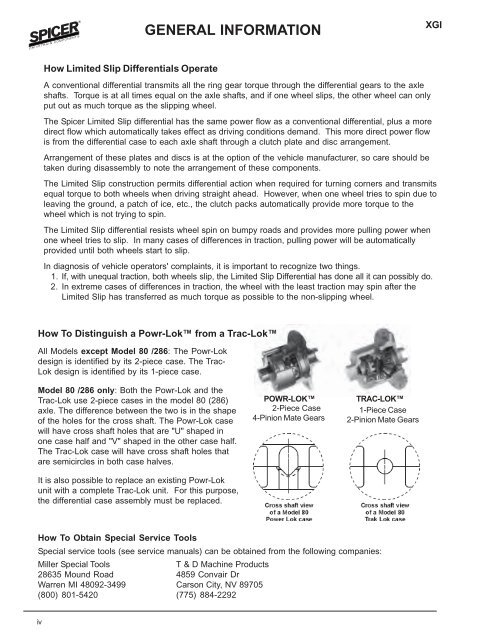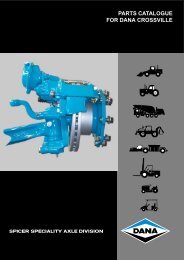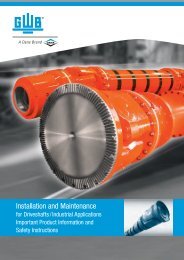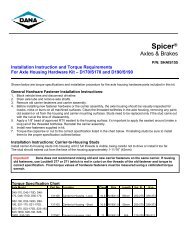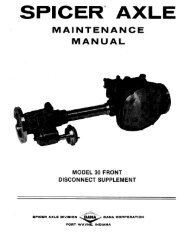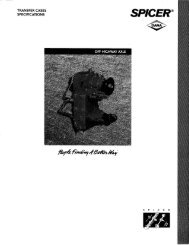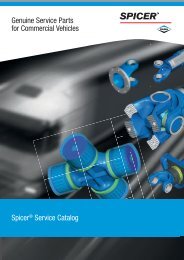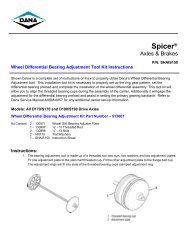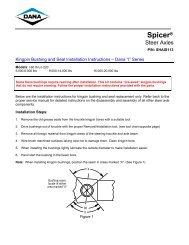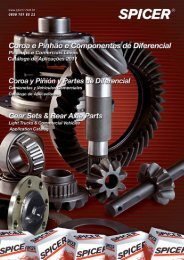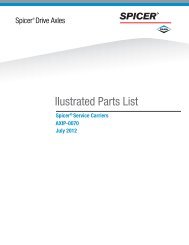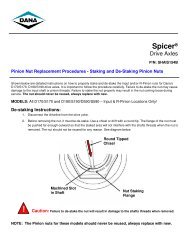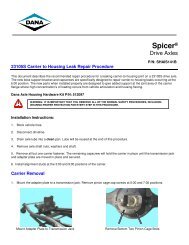2002 Spicer Axle General Information
2002 Spicer Axle General Information
2002 Spicer Axle General Information
You also want an ePaper? Increase the reach of your titles
YUMPU automatically turns print PDFs into web optimized ePapers that Google loves.
How Limited Slip Differentials Operate<br />
GENERAL INFORMATION<br />
A conventional differential transmits all the ring gear torque through the differential gears to the axle<br />
shafts. Torque is at all times equal on the axle shafts, and if one wheel slips, the other wheel can only<br />
put out as much torque as the slipping wheel.<br />
The <strong>Spicer</strong> Limited Slip differential has the same power flow as a conventional differential, plus a more<br />
direct flow which automatically takes effect as driving conditions demand. This more direct power flow<br />
is from the differential case to each axle shaft through a clutch plate and disc arrangement.<br />
Arrangement of these plates and discs is at the option of the vehicle manufacturer, so care should be<br />
taken during disassembly to note the arrangement of these components.<br />
The Limited Slip construction permits differential action when required for turning corners and transmits<br />
equal torque to both wheels when driving straight ahead. However, when one wheel tries to spin due to<br />
leaving the ground, a patch of ice, etc., the clutch packs automatically provide more torque to the<br />
wheel which is not trying to spin.<br />
The Limited Slip differential resists wheel spin on bumpy roads and provides more pulling power when<br />
one wheel tries to slip. In many cases of differences in traction, pulling power will be automatically<br />
provided until both wheels start to slip.<br />
In diagnosis of vehicle operators' complaints, it is important to recognize two things.<br />
1. If, with unequal traction, both wheels slip, the Limited Slip Differential has done all it can possibly do.<br />
2. In extreme cases of differences in traction, the wheel with the least traction may spin after the<br />
Limited Slip has transferred as much torque as possible to the non-slipping wheel.<br />
How To Distinguish a Powr-Lok from a Trac-Lok<br />
All Models except Model 80 /286: The Powr-Lok<br />
design is identified by its 2-piece case. The Trac-<br />
Lok design is identified by its 1-piece case.<br />
Model 80 /286 only: Both the Powr-Lok and the<br />
Trac-Lok use 2-piece cases in the model 80 (286)<br />
axle. The difference between the two is in the shape<br />
of the holes for the cross shaft. The Powr-Lok case<br />
will have cross shaft holes that are "U" shaped in<br />
one case half and "V" shaped in the other case half.<br />
The Trac-Lok case will have cross shaft holes that<br />
are semicircles in both case halves.<br />
It is also possible to replace an existing Powr-Lok<br />
unit with a complete Trac-Lok unit. For this purpose,<br />
the differential case assembly must be replaced.<br />
How To Obtain Special Service Tools<br />
Special service tools (see service manuals) can be obtained from the following companies:<br />
Miller Special Tools T & D Machine Products<br />
28635 Mound Road 4859 Convair Dr<br />
Warren MI 48092-3499 Carson City, NV 89705<br />
(800) 801-5420 (775) 884-2292<br />
iv<br />
POWR-LOK<br />
2-Piece Case<br />
4-Pinion Mate Gears<br />
TRAC-LOK<br />
1-Piece Case<br />
2-Pinion Mate Gears<br />
XGI


